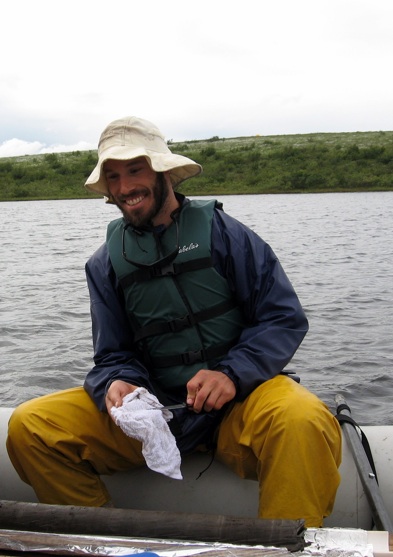Key words :
climate change,
paleoecology
,sun
,climate change
,positive feedback
,arctic
,energy
,environment
Ancient Tundra Fires Provide Clues for the Future of the Arctic
28 Mar, 2008 12:46 pm
The impacts of climate change in the Arctic depend strongly upon feedbacks between different components of the environment.
On land, some of the most important yet least understood positive feedbacks involve the role of wildfire activity in promoting the release of carbon and methane stored in soils and the permanently frozen ground (permafrost) underlying many Arctic ecosystems. Once in the atmosphere these compounds contribute to the greenhouse gases responsible for ongoing global warming. Unlike boreal forests to the south, we know little about how frequently tundra vegetation can burn and how climate and vegetation change affect wildfire activity in tundra ecosystems.
In the field of paleoecology (the study of past ecosystems) we adopt the view that one of the best ways to anticipate environmental responses to climate change is to understand how past climate changes affected past ecosystems. For example, in response to climate warming after the last ice age, many Arctic ecosystems reorganized into communities with little resemblance to what we see on the modern landscape.
We used the sediments preserved in small lakes in northern Alaska to study the fire history during the Shrub Tundra Period. Sediment cores from lakes are sliced into fine intervals, and within these intervals we isolate and count fossilized pollen grains and charcoal pieces to reconstruct vegetation and fire occurrence. With radiocarbon dating, we can infer when vegetation changed and how frequently fires burned in the past.
Overall, ancient sediments from Alaskan lakes provide clear precedence of shrub-dominated tundra burning at a much greater rate than observed in present-day tundra. This lesson from the past implies that the ongoing and future expansion of tundra shrubs, coupled with drier conditions due to increasing temperatures, could lead to increased burning in Arctic tundra and initiate important feedbacks with the climate system.
In the field of paleoecology (the study of past ecosystems) we adopt the view that one of the best ways to anticipate environmental responses to climate change is to understand how past climate changes affected past ecosystems. For example, in response to climate warming after the last ice age, many Arctic ecosystems reorganized into communities with little resemblance to what we see on the modern landscape.
One such community was a birch-dominated shrub tundra (Shrub Tundra Period) that covered the landscape from about 14,000 to 10,000 years ago. This ancient tundra was dominated by large shrubs, unlike most modern Arctic tundra. Its relevance to future Arctic environments comes from the fact that over the past several decades, shrubs have been expanding in tundra vegetation across the Arctic, largely in response to the well-documented warming occurring over this same period. These vegetation changes increase the overall biomass in tundra ecosystems, and combined with ongoing and predicted increases in temperature, they suggest that tundra fires could become more common in future decades than they have been in the recent past. With little evidence of tundra fires in modern landscapes, however, it is difficult to evaluate this possibility.
We used the sediments preserved in small lakes in northern Alaska to study the fire history during the Shrub Tundra Period. Sediment cores from lakes are sliced into fine intervals, and within these intervals we isolate and count fossilized pollen grains and charcoal pieces to reconstruct vegetation and fire occurrence. With radiocarbon dating, we can infer when vegetation changed and how frequently fires burned in the past.
Based on previous paleoclimate research, we know that climate during most of the Shrub Tundra Period was cooler and drier than present, and we expected that fires would be rare. To our surprise, we found that charcoal abundance, and the frequency of large charcoal peaks indicating fires, increased distinctly with the development of the shrub-dominated tundra, around 14,000 years ago. Records from two lakes suggest that the ancient shrub tundra burned every 144 years on average, a rate of burning similar to that of modern boreal forests and considered “frequent” relative to modern tundra.
The distinct increase in fire occurrence with the development of the ancient shrub tundra suggests that vegetation was a key element facilitating fires. Dry moisture conditions were likely an important component of the flammable ancient tundra, but cooler-than-present temperatures imply that climate alone was not main cause of frequent fires in the ancient shrub-dominated tundra.
Overall, ancient sediments from Alaskan lakes provide clear precedence of shrub-dominated tundra burning at a much greater rate than observed in present-day tundra. This lesson from the past implies that the ongoing and future expansion of tundra shrubs, coupled with drier conditions due to increasing temperatures, could lead to increased burning in Arctic tundra and initiate important feedbacks with the climate system.
Feedbacks between increased tundra burning and climate are inherently complex, but studies of modern tundra fires suggest the possibility for both short- and long-term effects. Tundra blackened from fires absorbs more of the sun’s energy than the green vegetation it replaced, increasing surface temperatures in the short term, and warmer surface temperatures can promote permafrost melting and increase decomposition rates. Both impacts would potentially release carbon and methane gasses to the atmosphere and increase greenhouse gas concentrations. Climate change in the Arctic, therefore, has implications for global climate as a whole. With a better understanding of how the Arctic has responded to past climate and vegetation changes, we can be much better equipped for anticipating the future in this vulnerable and critical region.


Montana State University researcher Philip Higuera examines a lake sediment core (the long brown object in front of his knees) from Little Isacheluich Lake in the Noatak National Preserve in the western Brooks Range of Alaska in June 2007. The sediment sample is similar to those Higuera examined for his research into fire occurrence on the ancient tundra. (Credit: Melissa Chipman)
Key words :






